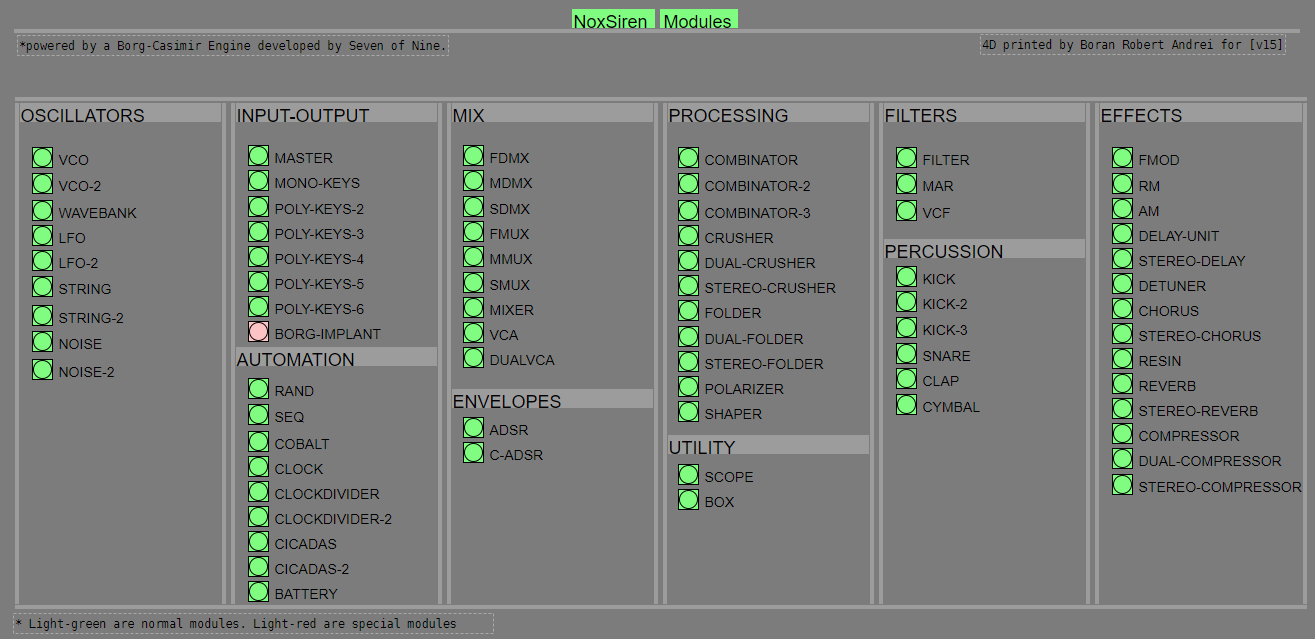best way to get various rhythmic tuplets of a metronome tick, as accurate as possible.
Hi,
I normally drive my patches in PD from one metronome, have counters selected to that metronome and select the rhythms I want from that.
What would be a good way to link up more than one metronome, and be able to have them operating at different tempos, yet still synched up? So a 2nd metronome is playing tuplets of the beat of the first metronome. I really want to get rhythms more interesting than multiples of 2s and 3s. And possibly have metronomes at different, but related tempos to get polyrhythms like 2 against 3 or 3 against 5.
I made a little test patch to get tuplets, but I think It can be tighter. I am using BPM, but I wonder if I should make some kind of converter to sample accuracy to make it a lot tighter.
NoxSiren - Modular synthesizer system <- [v15]
NoxSiren is a modular synthesizer system where the punishment of failure is the beginning of a new invention.
--DOWNLOAD-- NoxSiren for :
-
Pure Data :
NoxSiren v15.rar
NoxSiren v14.rar -
Purr Data :
NoxSiren v15.rar
NoxSiren v14.rar
--DOWNLOAD-- ORCA for :
- x64, OSX, Linux :
https://hundredrabbits.itch.io/orca
In order to connect NoxSiren system to ORCA system you also need a virtual loopback MIDI-ports:
--DOWNLOAD-- loopMIDI for :
- Windows 7 up to Windows 10, 32 and 64 bit :
https://www.tobias-erichsen.de/software/loopmidi.html
#-= Cyber Notes [v15] =-#
- added BORG-IMPLANT module.
- introduction to special modules.
- more system testing.
#-= Special Modules [v15] =-#
- BORG-IMPLANT (connects ORCA MIDI system to NoxSiren system)
#-= Current Modules [v15] =-#
- VCO (voltage-controlled-oscillator)
- VCO2 (advance voltage-controlled-oscillator)
- WAVEBANK (additive synthesis oscillator)
- ADSR (Attack-Decay-Sustain-Release envelope)
- C-ADSR (Curved Attack-Decay-Sustain-Release envelope)
- CICADAS (128 steps-Euclidean rhythm generator)
- CICADAS-2 (advance 128-steps polymorphic-Euclidean rhythm generator)
- COMPRESSOR (lookahead mono compressor unit)
- DUAL-COMPRESSOR (2-channel lookahead mono compressor unit)
- STEREO-COMPRESSOR (lookahead stereo compressor unit)
- MONO-KEYS (virtual 1-voice monophonic MIDI keyboard)
- POLY-KEYS-2 (virtual 2-voice polyphonic MIDI keyboard)
- POLY-KEYS-3 (virtual 3-voice polyphonic MIDI keyboard)
- POLY-KEYS-4 (virtual 4-voice polyphonic MIDI keyboard)
- POLY-KEYS-5 (virtual 5-voice polyphonic MIDI keyboard)
- POLY-KEYS-6 (virtual 6-voice polyphonic MIDI keyboard)
- BATTERY (simple manual triggered machine for drumming.)
- REVERB (reverb unit with lowpass control)
- STEREO-REVERB (stereo reverb unit with lowpass control)
- RESIN (advanced rain effect/texture generator)
- NOISE (generates black,brown,red and orange noise)
- NOISE2 (generates yellow,blue,pink and white noise)
- COBALT (6-stage polyrhythm generator)
- SHAPER (basic shaper unit)
- FOLDER (basic wave folding unit)
- STEREO-FOLDER (stereo wave folding unit)
- DUAL-FOLDER (advance wave folding unit)
- POLARIZER (transform a signal into bi-polar, uni-polar, inverted or inverted uni-polar form)
- CLOCK (generates a BPM clock signal for sequencing other modules)
- CLOCKDIVIDER (a clock divider with even division of clock signal)
- CLOCKDIVIDER2 (a clock divider with odd division of clock signal)
- DELAY-UNIT (delay unit)
- STEREO-DELAY (stereo delay unit)
- CHORUS (chorus unit)
- STEREO-CHORUS (stereo chorus unit)
- SEQ (advance 16-step/trigger sequencer)
- KICK (synthesize kick unit)
- KICK2 (synthesize flavor of KICK module)
- KICK3 (synthesize flavor of KICK module)
- SNARE (synthesize snare unit)
- CLAP (synthesize clap unit)
- CYMBAL (synthesize cymbal unit)
- RAND (RNG generator for other modules parameters)
- FMOD (feedback modulation unit)
- AM (amplitude modulation unit)
- RM (ring modulation unit)
- LFO (low-frequency-oscillator)
- LFO2 (advance low-frequency-oscillator)
- COMBINATOR (combine two waves)
- COMBINATOR2 (combine three waves)
- COMBINATOR3 (combine four waves)
- STRING (Karplus-Strong string synthesis unit)
- STRING2 (advance Karplus-Strong string synthesis unit)
- DETUNER (parametric 4-channel detuner unit)
- CRUSHER (basic audio resolution unit)
- STEREO-CRUSHER (basic stereo audio resolution unit)
- DUAL-CRUSHER (advance audio resolution unit)
- FILTER (basic filter)
- VCF (voltage-controlled-filter)
- MAR (Moog-analog-resonant filter)
- VCA (voltage-controlled-amplifier)
- DUAL-VCA (advance voltage-controlled-amplifier)
- FMUX (multiplexer with fast A/D internal envelope)
- MMUX (multiplexer with medium A/D internal envelope)
- SMUX (multiplexer with slow A/D internal envelope)
- FDMX (demultiplexer with fast A/D internal envelope)
- MDMX (demultiplexer with medium A/D internal envelope)
- SDMX (demultiplexer with slow A/D internal envelope)
- MIXER (mix 1-4 possible waves)
- SCOPE (oscilloscope analyzer)
- MASTER (fancy DAC~)
- BOX (useless decorative module)
NoxSiren integrated modules menu system.

Luclydean :::> Euclidean Step Sequencer with Camomile
Here an Euclidean Step Sequencer VST, testing dynamic patch using Camomile (thanks Pierre Guillot). It works!
Adapting a patch for my needs
Hello, I am a beginer and I found a very interesting patch that can feet almost exactly what I want to do.
The only issue is that I am currently limited by my knowledge to change its input. The patch is supposed to generate a euclidean rythm from a midi input. I would like to skip the midi part and to generate those rythms with simple click sounds.
Here is the patch with a couple of comments.
Thank you very much for your help.
Ofelia Jump On Click Slider
@Jona Nice sequencer! I couldn't hear the sound because I don't have [Additiv-syntes] abstraction. I think one would be able to easily create some interesting polyrhythmic sequences using them. 
Euclidean Rhythms
yo... i totally forgot about this thread after i posted that video.
since doing that video i have lost my original patch, and cant really remember exactly what the patch looked like but the math was simple (not as simple as stutter's)
sorry i forgot all about it.
in other news, the IOS app 'figure' is using a euclidean algorithm to produce its percussion (i think...)
Euclidean Rhythms
Hi all,
Just bumping this thread as I discovered a MUCH more elegant and simple implementation of the above.
I had a faint feeling from the start that the implementation of the algorithm as presented in the seminal paper on Euclidean rhythms, although easily comprehensible and human-readable, wasn't actually a very sensible implementation for computational applications - especially since Euclid's algorithm as it exists in mathematics is just a recursive numerical method for performing division and calculating remainders. Given that computers are pretty nifty with dividing and remainders already, I thought, they ought to be able to cut to the chase and get the results much more easily than that.
Today I finally sat down to some pen-and-paper work to try and figure out what simpler way there might be to implement the algorithm, and I suppose my intuition turned out to be right, as I managed to distill the whole thing down to a handful of operations (and without needing to pregenerate a list, either!) Behold:
[inlet]
|
[+ A]
|
- |
[% C]
|
[< B]
|
[select 1]
|
[outlet]
does the trick, where integers B and C are the desired number of hits per 'bar' and the total number of beats per 'bar', respectively, and A is the 'rotation' or 'offset' applied to the rhythm. Then you feed the [inlet] with a metro-powered [f ]x[+ 1] counter, and you'll get a 'bang' out every time the drum should trigger. Have attached an abstraction which performs the same.
Would have preferred to get this out back when there was a lot of buzz surrounding the Euclidean algorithm so that more people might've seen it, but I guess it's still better than nothing. Also, forgive me if this is all old news and has already been figured out elsewhere!
Composition techniques
I do a lot of algorithmic composition. Usually there's a fairly rapid [metro] as the master clock, and I divide it with various counters. It's easy to make polyrhythms this way. These drive different sequencers that do something or other. Usually I'll record each part to its own .wav file and arrange it with a DAW, export and then reprocess through Pd for effect processing. Or I'll make some chaotic or drone patch and just record some length of that, and arrange later. I never really do "one patch per entire piece". It's too much of a headache.
Euclidean Rhythms
Hello everybody:
I tried to learn about the implementation of that algorithm but got sort of lost inside the guts of euclidean.pd, so I went through G. Touissant's publication and made something like that using a table and lists, as @sebfumaster was asking for.
As far as I could read in a PhD Thesis (Musical Rhythms in the Euclidean Plane) from Perouz Taslakian, a student at the same university as G. Touissant, the original patch uses two different algorithms depending on the proportion of hits to remaining rests. The matricial approach is adequate for that but quite troublesome (IMHO) in pd. If your amount of hits is less than the amount of rests (k <= (n-k)) it goes somewhat like this: It consists in putting a whole bar like this on the first line, for instance:
n=8, k=3
22211111 (twos are hits and ones are rests, the rest of the empty matrix is zeros)
Then you begin moving the remaining ones one row below the twos, which stay on first line, and moving what remains at the second line "out of the shade" of the previous line to the third one:
222
11111
... until you have a pack like this:
222
111
11
Then you start reading column wise and from left to right, obtaining:
21121121
where: '211' comes from the first column, '211' from the second and '21' from the third one.
The method for more twos than ones is something alike but with slightly different rules.
I saw that for this second condition the answer is the same if one inverts twos and ones and reverses the bar, then solves it using the first method. After that one must invert again and reverse. For instance:
k=3, n=5:
22211 -> invert -> 11122 -> reverse -> 22111
Solving in a matrix:
22
111, etc...
...until:
22
11
1
Read columnwise and from left to right: 21121
Then reverse again: 12112 and invert: 21221.
I found that euclidean rhythms can be made by using a table, putting the starting vector in the same manner and reading it in an alternate way, using division reminders to find out the pointers to the table. Well it's done like that in my patch and it's very easy to follow. However, the rhythms are not exactly the same as euclidean.pd patch gives but since phase shifted euclidean rhythms are equivalent, it doesn't matter to me at least. No matrix button this time.
I think that with not so much work you can turn it into what you are looking for.
Thank you very much @kyro and @mrcold to introduce me to this. It has been something I was going to need soon.
Sumidero
PD: I appologise for the extension of this post 
Euclidean Rhythms
Here's my implementation with a matrix. It outputs a list of 1's and 2's for weak and strong steps respectively.


